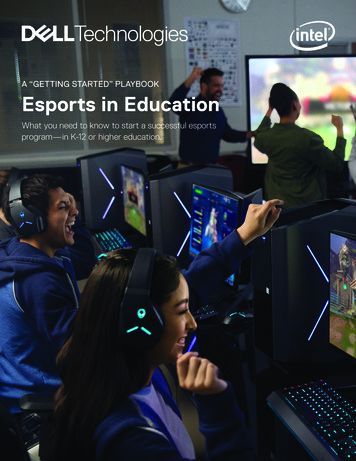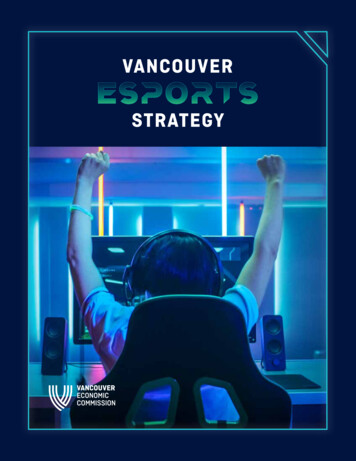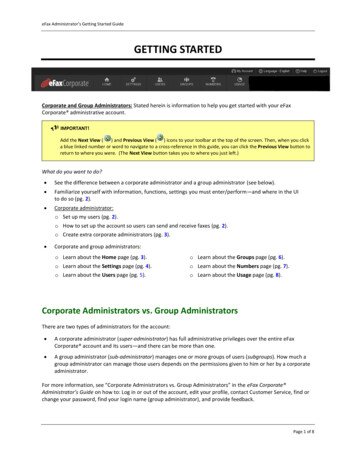
Transcription
A “GETTING STARTED” PLAYBOOKEsports in EducationWhat you need to know to start a successful esportsprogram—in K-12 or higher education.1
A “GETTING STARTED” PLAYBOOKEsports in EducationEsports is proving to be a game changer for students, schools, and the broader globalcommunity. More schools from K-12 through collegiate institutions are looking to get inon one of the fastest growing spectator sports and multi-billion-dollar industries around.Opportunities abound not just for recreational or competitive play, but also for those lookingto play a role in supporting the program, from shoutcasting to video production to analytics.Esports is also having a tremendously positive impact in academics, especially in STEAM(Science, Technology, Engineering, Arts, and Mathematics). But many struggle with whereto begin and what a successful program might look like for their school. If you find yourself inthat camp, this playbook is meant for you. Herein we outline what questions you need to ask,how to go about getting the answers, who should be involved, how to map out a workablestrategy, and how you can execute on that strategy to make the future of education andentertainment a reality for your school today.Esports is leading to new career and technical education (CTE) pathways“Our approach to esports is to focus on college and career-readiness. As a result,every event that is implemented by our school district includes an educationalcomponent. College representatives and industry professionals meet with ourstudents during our events, and provide ongoing mentoring at district campuses,and we also have a robust esports and event job-shadowing program. By usingthese innovative approaches to education, BISD is preparing its students for thetypes of careers offered by high tech companies.”Dr. Leslie Bender Jutzi, Chief Academic Innovation Officer, Burleson ISD (BISD)2Table of Contents4681415Esports in education: a passing fad or here to stay?Start the conversation.Map out a strategy.Get buy-in.Recommended configurations.3
Esports in education:a passing fad or here to stay?Our vote is ‘here to stay’. And here’s why Esports is much more than competitive gaming. It’s reshaping entertainment and presenting powerfulnew opportunities for growth in education from K-12 to higher education.Students who engage in esports are developing real-world skills that prepare them for the future—including building student relationships, personal confidence, collaboration, and problem-solving skills.1Highly competitive multiplayer games like League of Legends, SMITE, and Overwatch are teachingstudents how to shift their focus from individual distinction towards the greater team goals. Theseexperiences provide a new approach to engaging students in peer collaboration, communication, respect,as well as new opportunities for leadership.The roles that exist in and around an esports program also go well beyond team play. Students who don’tparticipate in playing the game can still take part in the success of the program. Students interested incomputer science, for example, can learn how to analyze gameplay data to improve player skills, realizingthat basic math and comparison metrics provide a higher-level understanding of the game dynamics toprovide players with a competing edge. Others who have a keen interest in communications and socialmedia might join as shoutcasters. The list goes on. With an esports program, students are introducedto state-of-the-art technological tools and skills that are actively preparing them for career pathways inSTEAM disciplines, finance, marketing, graphic design, programming, health and wellness, and beyond.Esports: A Numbers Game557 MILLION VIEWERSEsports can create new avenues to generate local and nationalmedia interest for your school. Did you know it’s projected toattract a total viewership of 557 million by 2021. That’s moreviewers than every other U.S. professional sports league.3A 1.4B INDUSTRYEsports, having reached revenues of 869 million in 2018, will soonbe a billion dollar plus industry. It’s also part of a much larger, twohundred billion dollar gaming industry.4LOW STARTUP COSTSIs esports for everyone?97%4The start-up costs for esports programs are significantly lowerthan for most other school sports or activities.5 For a start-upthat’s a fraction of most single sport entry and already has anoverwhelming and quickly growing spectator interest, the positivebenefits esports programs generate for schools is substantial.of teens play video games, according to a Pew Research Centerreport.2 Due to its widespread popularity, esports is helping to breakdown barriers among diverse student groups, often including a partof the student population that may not otherwise join a team sport.5
Start the conversation.Like any new venture, start by gauging interest and initiating the flow of questions that will shape youresports program. These discussions are critical to constructing a curriculum, setting goals, and making sureyour program operates and grows successfully. We recommend talking with:STUDENTSThe conversation must begin with the students,where interest in having an esports program islikely high. Consider creating a survey to gaugeinterest levels, and then bring those studentswho have expressed interest together to meetand discuss opportunities and goals. This canbe especially helpful since these students areoften equipped with the knowledge to lead thesediscussions and identify their wants and needs. AtNYIT, for example, the esports team ‘Cybears’ was“born out of a student-led initiative,”6 which hasgrown into a nationally recognized team seen onnews networks including ABC, CBS, and FOX.7PARENTS & THE COMMUNITYFor K-12 schools, this includes talking to districtleaders, school board, parents, and othercommunity leaders. For higher education, this mayinclude parents, administration, the athletic director,and department heads. Some may have someinitial skepticism and legitimate questions that willhelp guide you to ensure your program starts offsuccessful in everybody’s eyes.ITEsports differs from traditional sports in that itsbackbone of equipment and the “field” largely relyon your IT department and the technology needed.You’ll want to understand what will be requiredfrom a technical perspective, , including whattypes of gaming stations, network, infrastructureand supporting technology might be needed. Thenestablish a baseline, and set a goal of where youneed to be in order to stand up your program.6COLLEAGUESColleagues can offer valuable guidance and help.How do they see the program integrating with theacademic curriculum? What impacts and concernsdo they have about how this will affect thestudents? Should they be involved, and if so, whatcan they do to help?SCHOOLS WITH ESPORTS PROGRAMSBecause of how recent esports has grown intohigher education and more recently in K-12, it canbe extremely beneficial to identify those schoolsthat have successful esports programs already, tounderstand first-hand what kind of lessons needto be learned and to build off their successes.ESPORTS LEAGUES & ORGANIZATIONSThese groups can be a direct source of knowledgein helping to grow your program and ensure youalign with their policies and practices. For bothK-12 and higher education, this can include the EGFederation, and for higher education, there is theNational Association of Collegiate Esports (NACE).High school programs include PlayVS, the NationalFederation of State High Schools Associations andthe High School Esports League, who published a2019 Esports League Handbook.INDUSTRY LEADERSAs esports quickly grows, there are severalconsistent and experienced leaders within theindustry, including technology brands like DellTechnologies and gaming companies like SkillshotMedia, Hi-Rez Studios, Riot Games, and BlizzardEntertainment, that are skilled at understandinghow to help you get started and build as you moveforward on your journey.Tip: “Don’t underestimate student interest.”“A key take away for you, if you’re starting an esports program, do notunderestimate the level of interest from students. Being a CTO for about 20years, this was the biggest thing I ever underestimated in my career. In our firstyear, we settled on 75 students but we had to turn away 150. This next year weanticipate probably being 250 and grow from there.”Kyle Berger, Chief Technology Officer, Grapevine-Colleyville ISD7
Map out a strategy.Using the answers and details provided from your conversations, you can start to define what the goals ofyour program will be and what’s needed across four key areas: academic, logistic, technology, and financial.ACADEMIC GOALSWhile esports is a sport, the connections with academic programs and applications in STEAM career fieldsand education are unparalleled from any other athletics program. To help identify what types of academicprograms will be involved, ask questions like: What are the suggested career pathways for both students and faculty? What teaching and learning disciplines can be associated with the program?THE LOGISTICSLike all athletics programs, there is a list of questions to answer to plan the operation and growth of youresports program—starting with whether your program will exist within student affairs, athletics, intramuralsports, or other areas. Subsequent logistical questions include:What games will you play?This can include both the genre and type of games as well as the rating ascribed by the EntertainmentSoftware Rating Board (ESRB). For example, many esports programs have rules that exclude first shootergames and will limit or not sponsor games that have an ESRB rating of Teen and above. The category orgenre of esports games are useful metrics to help evaluate games. Popular designations include:FPSFirst Person Shooter, such as Counter-StrikeMOBAMultiple Online Battle Arena, such as SMITE and League of LegendsRTSReal Time Strategy, such as StarcraftSports and FightingSuch as Smash Brothers and Street FighterMiscellaneousFor games that don’t fit into any of these categories, such as Overwatch,Hearthstone, and Tetris What new academic areas of study and research, such as design theory, could be introduced? What types of impact do you anticipate to your campus culture, community, and student success? What student performance metrics will you monitor as your program grows?What leagues will you be involved with?There are several leagues available both in higher education and in K-12. American Video Game League is forcollegiate play, while PlayVS, the National Federation of State High Schools Associations, and the EsportsHigh School League cater to high school teams. The EG Federation is for both. Beyond the league, identifythe rules and regulations necessary for your students to join and compete in that league to ensure that theyalign with your overall program objectives.Esports Education Resources for K-12Dell Technologies offers resources, developed in collaboration with educationand esports industry experts, to help jump-start K-12 esports programs: Esports Learning Guide for Teachers and Coaches Esports Professional Learning Esports Coaching Clinic8How long will the program run?Depending on the goals of your program, this could mirror the seasons and events of the leagues you join, orfollow your academic or athletic program’s calendar.Who will be involved in the planning and execution?When considering faculty, you should first identify a senior-level manageror administrator as a champion to lead the planning and execution.From there, you can start thinking about appointing or hiring dedicatedcoaching staff, a program supervisor for competitive and recreationalplay, administrative support for personnel, fiscal resource management,and facilities management, or even positions to support possiblecurriculum development or research opportunities related to esports andgame design.Tip: Think aboutinvolving talentedstudent interns tofill needed roles.9
What are your policies and rules of engagement?Many schools are aligning their programs and players with guidelines of similar sports programs. For collegiateplay, for example, schools often follow NCAA rules even though esports is not sanctioned through NCAA.This can require students to maintain a minimum GPA, achieve attendance standards without excessiveabsences, and ensure accounts are in good standing with no outstanding dues, fees, fines. Your policiesof engagement should also describe what types of games your program will pursue, as well as how you’llpromote good user behavior, digital citizenship, and sportsmanship to maintain Title IX compliance.How many students will you accept into the program?This includes the number of players, and those that will play a supporting role. If numbers of interestedplayers exceed the number of gaming stations available, consider segmenting into groups with certain groupsplaying on given days. Or for those looking to have a competitive team, you might have to hold tryouts toidentify the best players.Will you have local tournaments and how do you leverage prizes/awards?While esports remains officially unsanctioned by the NCAA largely because of cash prizes and other awards,these remain effective ways to quickly build interest and discover talent. Hosting tournaments or events arealso good ways to bring in new revenue streams for your school.How are esports different fromother NCAA / traditional sports?Esports games are the intellectual property of theirdevelopers, which are typically commercial enterprises. Forexample, Riot Games owns League of Legends.Esports leagues typically offer scholarships, cash, orequipment prizes to the top three winners, which goes againstthe NCAA’s policies and commitment to “amateurism,” whichis why esports are not a sanctioned sport.Esports prizes can impact student financial aid qualificationsand possibly have tax implications for your institutions,depending upon how prizes are received and managed.Esports Title RatingsThe ESRB provides ratings for game titles that can be a useful metric whenevaluating which esports to sanction. The two main appropriate ESRB ratingsinclude Everyone (E) ratings which include games that may contain minimalcartoon, fantasy or mild violence, and Teen (T) ratings which include games thatmay contain violence, suggestive themes, crude humor, minimal blood and/orinfrequent use of strong language.THE TECHNOLOGYAs its name suggests, a critical foundation of esports is the technology and tools that support its operation.The underlying infrastructure, computer devices, and end-to-end security open up a new level ofnetworking that goes beyond most school’s traditional education requirements while requiring a higher levelof security that can extend to all of your architecture and keep everyone safe.What are the primary tools for supporting your esports infrastructure?The basic components of your esports supporting technology are the gaming stations and afast, reliable network. For more advanced programs, like those incorporating video productionor for games run on premises, you may also consider adding dedicated servers and storage.Gaming Stations: The required functionality and performance specifications will largely be dictated by thetype of game(s) you choose, the number of players involved, and the type of play you engage in (whetherclub or competitive). Check with the gaming manufacturers to confirm the needed specifications. Somegames may run well on laptops while others require dedicated high-performance gaming platforms likeAlienware desktops outfitted with the needed specially-designed gaming keyboards, mice, and headsets.Network: Because players often compete through a wired network connection, esports networks aretypically optimized with 100Mb of unfiltered internet access to each gaming station to minimize theimpact of network latency which negatively impacts play.“One of the things that we like about esports is the waythat students have applied a 21st century business modelto it. As a result, high school students have an opportunityto play games and earn scholarships.”Tip: Don’t go wireless! With interruptions likely from other devices, WiFi is too unstable tosupport the heavy demands from online gaming, especially multi-player, graphic-intensivegames like those played in esports.Dr. Leslie Bender Jutzi, Chief Academic Innovation Officer, BISD1011
Servers: Depending upon the scope of your program, servers may be needed to run on-premisegames while also supporting additional activities like video editing and production, shoutcasting andlivestreaming, analyzing data from gameplay as well as running analytics from social media feeds anddriving audience viewership experiences.Storage: Esports require resources equipped to handle the storage and transfer of large volumes of data.Both flash and hard-disk storage are used for broadcasting, management for analytics, supporting arenaor audience viewership experiences, and recording player statistics and gameplay for review, playback,and training.FINANCIAL CONSIDERATIONSWhen making your financial plan, consider the areas outlined in the table below. As you do, it’s importantto understand that while the technological requirements for esports may appear substantial at the outset,“there’s not a single sport within traditional sports that even comes close to [esports] low level of entry,”according to the National Association of Collegiate Esports (NACE). Some schools like The University of Akronmay be investing millions into esports facilities and equipment, but the average startup costs are only around 43,000.5 Depending on the equipment and experience your school has access to, there is often no need forhigh investment costs to get started. Likewise, due to the nature of the types of machines and technologyesports programs are using, it’s easy to slowly scale your equipment and budget as your program grows.What to include in your gaming space or arena?Gaming spaces don’t need to start out big or include much more than the technologyeach player needs. Spaces can be as small as a 2 to 5-player kiosk or as large as 100seat gaming arenas. Size depends on the scope and engagement of your program. Inaddition to gaming stations for each player, spaces that are used for competitive playcan also include a coaches’ station per team and large format displays incorporatedaround the space for audience viewing and/or coaching sessions. If you’re introducingshoutcasting and broadcasting opportunities for your students, think about planninglocations where commentary doesn’t interrupt ongoing competition.Tip: Think about leveraging your computer lab to get started. Often, the needed computetechnologies and space are already available. Coaches and coaching staffFaculty andAdministration Program supervisor and potential supporting staff, these may separatefor both competitive and recreational play Administrative support for personnel, fiscal resource management, andfacility management Support for curriculum development and research opportunitiesassociated with esports and game designTechnology Gaming stations Networking Servers Video editing and dataanalytics software/hardware Storage School-branded jersey and othermerchandise (like backpacks)Player Equipment& Miscellaneous Marketing/logo design Power strips Room décor Streaming webcams12 Keyboards Mice/mousepads Headsets Security locks In-house events Food/travelTIPS FOR HIRING A COACHFinding a coach for your esports players may be a new adventure, but it doesn’t need to bea large investment or a difficult one, especially with the rise in esports popularity. Consider:Local college students, retired professionalgamers, and local competition winners.Did you know? Several colleges anduniversities support or accept mentoring K-12esports teams as college credit or communityservice hours.An expert in a specific game, who willbe more helpful than a “jack-of-all-trades.”Someone who excels in one game will end upbeing more beneficial to helping your student’scompetitive skills than someone who claimscoachable experience in several games. Decals13
Get buy-in.Gaming SolutionsRecommended configurations for your Esports platformBALANCE CREATION, ENTERPRISE MANAGEABILITY AND PERFORMANCEInterest may start with the students, but buy-in needs to come from students, parents, faculty,administration, and for K-12, school board and district leaders. Securing this kind of interest meansovercoming the stigma and skepticism of how video games were perceived in the past, as a “loner’sactivity,” and showing what esports has instead become: legitimate, challenging and engaging teamsports that require students to interact both on campus as well as across the world.Dell Precision WorkstationsDell Precision has over 20 years of innovations for power users. The Precision productteam works directly with our customers and our strategic partners to deliver themost reliable and powerful PCs from Dell. The intelligent performance is driven byprofessional-level components and capabilities, featuring:Here are some interesting points to make as you build your case: Intel Core and Xeon processors Many students interested in esports are not involved in any other school or community activity. And whenkids get involved the stats are impressive, indicating that a majority of students increase their overallgrade-point-average, attendance, and extra-curricular engagement.7 Fast memory (including ECC memory options) and scalable storage Unlike other athletics programs, esports is open to many students with mental and physical disabilities,and it does not discriminate and separate leagues by gender. Testing/certification process for optimized performance and mission critical reliability It uniquely helps prepare students for a bright future by equipping them with skills that translate todisciplines across STEAM, business, health and wellness, marketing, finance, design, and more. Commercial product lifecycle management for predictable product transitions Scholarships and grant opportunities are available for students in higher education, especially thosepreparing to major in technology and science fields like computer science or game design.Establish Partnerships with Industry LeadersNavigating the complexities of implementing an esports program can seem daunting at first, but with theright help, it doesn’t need to be. Trusted companies like Dell Technologies and other entertainment andgaming experts are available to provide guidance and assistance. By working alongside schools like yours,whether K-12 or higher education, industry leaders can help ensure seamless and scalable deployments ofinterconnected esports technologies.Start Small, Grow as You GoStarting your esports program small at the outset enables you to make the changes needed over thefirst few years of implementation and to develop a course curriculum that makes sense over time. Manyteachers and officials involved at these schools quickly discover that they underestimated how popularthe program would be. Therefore, it makes sense to set a goal or date after the first year to sit down andevaluate your program’s success and reevaluate your goals.Refine, Cross-Pollinate, and Extend OutAs your program matures and builds momentum, consider bridging across academic disciplines as well asstrengthening connections or forming new ties with other schools and organizations. For K-12, you mightalign with other relevant courses. like marketing finance, graphic design, while for colleges and universities,you can involve other schools or research teams to explore esports. For example, the architecture curriculumat NYIT is collaborating with their esports program to help design their esports arena of the future.14 Professional graphics from AMD and NVIDIA Exclusive Dell Precision Optimizer software to increase productivity Dell Client Command Suite for commercial-level IT manageabilityAlso, Precision provides for immersive productivity through our designs and capabilitiesto drive emerging technologies such as VR and AI and deliver outstanding performancefor gaming development and consumption, including esports.THE ULTIMATE GAMING EXPERIENCESAlienware Gaming PCsThe genesis of Alienware began over 20 years ago, in 1996, when a group of gamersdecided to start what is today the world’s leading brand in high performance, awardwinning, gaming PCs, and the leading innovator in the category. Based on a customerfirst approach that feeds on a drive to innovate with the mission of delivering the mostimmersive gaming experience in the galaxy, Alienware systems feature: Advanced CPU Liquid Cooling (desktops) and Cryo-Tech (notebooks) coolingtechnologies for no-compromise gaming performance and overclocking capabilitiesfor Intel Core and AMD Ryzen processors alongside HyperX FURY XMPmemory Alienware Command Center software to centralize the settings of your entireAlienware ecosystem including specific profiles for thermals, power, AlienFX lighting, per-game settings, and overclocking toolsOur fleet of Alienware systems and peripherals are also proudly used by esports leaguesand professionals around the world including at the Alienware Training Facility forTeam Liquid in Los Angeles. A second training facility is expected to celebrate a grandopening in Utrecht by early 2020.15
Gaming PeripheralsEnhance the esports experience with gaming peripherals.Alienware Gaming MonitorsEnhance the gaming experience as your players journey deeper into the game.Choose from a wide variety of sizes and formats, all with incredible resolution.Infrastructure SolutionsMaximize performance of your IT environment for a seamless, secure gaming experience.GAMING AT THE VARSITY LEVELDell EMC Networking SolutionsDell EMC PowerSwitch open networking and firewallsolutions deliver enterprise-grade high performance tosupport peak competitive gaming action.Alienware Gaming ChairsAlienware Gaming Chairs are a gamer’s delight. The racing-style gaming chairfeatures a wide range of adjustability that provides gamers with the best comfortand ergonomic support in every position for extended periods of time.VIDEO CONTENT CREATING AND DISTRIBUTIONAlienware 7.1 Surround Sound HeadsetThe Alienware 7.1 Gaming Headset combines best-in-class handpicked drivers andcustom-designed acoustic chambers and earcups to deliver the audio experiencethat the developer intended, accurate surround sound positioning, and unparalleledclarity during even the most chaotic gameplay.Dell EMC Isilon Storage and Dell Precision WorkstationsElevate streaming beyond casual for team promotion,recruiting, marketing, coaching, game analytics and more.Dell EMC Isilon storage, paired with Dell Precisionworkstations, supports real-time creation and distributionof compelling content across multiple formats includingbroadcasting or video on demand (VoD).Alienware Wired/Wireless Gaming MouseThe Alienware Wired/Wireless Gaming Mouse is a no-compromise, fully featuredgaming mouse created to provide gamers with the best wireless gaming experience.Alienware Low-Profile RGB Mechanical Gaming KeyboardThe Alienware Low-profile RGB Mechanical Gaming Keyboard is a full featured,maximum performance keyboard that incorporates the latest generationlow-profile Cherry MX keys in a floating key architecture with anti-ghostingand per-key lighting.ARENA CONTROL AND VIEWER EXPERIENCEDell Boomi and Dell EMC Infrastructure SolutionsLeverage the portfolio of Dell Technologies companies toprovide your viewers with the best experience. Control thearena, integrate gaming stats into apps and systems and bringyour viewers closer to the action.Don’t see what you need?:Dell offers a wide range of gaming peripherals from Dell and industry leading partners.1617
It’s an exciting time to be joining the fast-growing esports movement. We are living in the‘digital era,’ and while digital transformation is a top priority across all industries—esportsis a powerful embodiment of that transformation. Dell Technologies and Intel are helpingschools like yours make the digital transformation real today. From the world’s leadinghigher education esports programs to schools starting out in K-12 esports, we have thetransformative technology solutions and the experience to make the future of educationand entertainment a reality in your school today.Learn es.com/K12your Dell TechnologiesEducation ExpertFollow us@DellEMCEdu1. Connected Learning Alliance: Not Your Traditional Athletics Program: TheValue of Esports in Education. http://bit.ly/2ZySPpe5. The James G. Martin Center for Academic Renewal: Collegiate EsportsPrograms Are Here to Stay. http://bit.ly/2KWMo7m2. Pew Research Center: Teens, Social Media & Technology 2018. https://pewrsr.ch/325Ffat6. New York Institute of Technology Athletics: The Cybears. http://bit.ly/2L4U0n23. Whitman Syracuse University: With Viewership and Revenue Booming,Esports Set to Compete with Traditional Sports. http://bit.ly/30GdZPQ7. We are Teachers: Video Games Are the New Competitive Sport in Schools.http://bit.ly/2NCsnVh4. Newzoo: Newzoo’s Esports Business Predictions for 2021. http://bit.ly/2zlGHt4THIS WHITE PAPER IS FOR INFORMATIONAL PURPOSES ONLY, AND MAY CONTAIN TYPOGRAPHICAL ERRORS AND TECHNICAL INACCURACIES. THECONTENT IS PROVIDED AS IS, WITHOUT EXPRESS OR IMPLIED WARRANTIES OF ANY KIND.Copyright 2019 Dell Inc. or its subsidiaries. All Rights Reserved. Dell Technologies, Dell, EMC, Dell EMC and other trademarks are trademarks of Dell Inc. or itssubsidiaries. Other trademarks may be trademarks of their respective owners.
LOW STARTUP COSTS The start-up costs for esports programs are significantly lower . be a billion dollar plus industry. It’s also part of a much larger, two hundred billion dollar gaming industry.4 557 MILLION VIEWERS Esports can create new avenues to generate local and national media










